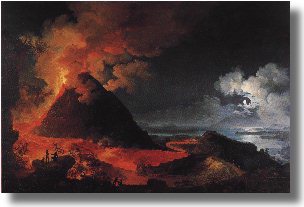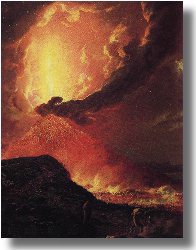Vesuvius
an important lap in the Grand Tour
of intellectuals in the 1700's
by Rita Messeri
As of 1600 and throughout the eighteenth century, the journey, intended as a moment in the individual's moral and cultural formation, became practically an institution. A practice, of course, reserved to the aristocratic class, artists and men of letters.
The classic itinerary of these travellers, which was referred to as "Grand Tour," foresaw the descent along the Tyrrhenian coast with several deviations inland into Central Italy, then down into Southern Italy and finally northwards.
With his Italienische Reise (1816-17), J.W. Goethe (1749-1832) is without a doubt one of the most famous protagonists of these itineraries. Of the many British pioneers, in the fall of 1840 we find the then twenty-one-year-old John Ruskin (1819-1900) who, a few years later, was to become professor of art history at Oxford and one of the greatest art critics.
Moonlight Eruption of Vesuvius, 1774 ca. (Pierre-Jacques Volaire, 1729-1792) |
 |
From his travelogue emerge extraordinary images, water-colours and sketches which document the impressions of light, shadow and colour of the Italian landscape in the century of the great art travellers. "... finally, we reached the beach. The moon was high, full and beautiful and for the first time, I caught a glimpse of Vesuvius, a dark grey shadow that stood out in the moonlight and I felt myself again. The Neapolitan pages of Ruskin's journal reveal the constant presence of Vesuvius. Whether in good weather or bad, with the light of dusk or moonlight".
"Vesuvius lay beneath a mass of white clouds, its smoke blending with them in magnificent and changeable spires; the sun struck the cone's snow-capped peak and the steam that fell back onto the slopes... I went out just in time to see the sun setting on Vesuvius against a clear sky, marked only by a strip of grey clouds right behind the crater; at dusk, the smoke was as clear as snow, exquisitely beautiful in its variableness... Vesuvius is without a doubt far more majestic than I had supposed."
(above) An Eruption of Vesuvius, 1774 (Jakob Philipp Hackert, 1737-1807)
(left) Vesuvius erupting with view of islands in the Gulf of Naples, 1679-1680 ca. detail (Joseph Wright of Derby, 1734-1797)Long before Ruskin, the obsession to describe the volcano also captured, among the many foreign landscapists, Pierre-Jacques Volaire (1729-1792 ca.) who worked in Italy from 1764 and in Naples from 1769, specialising in views of Vesuvius erupting in the moonlight.
An obsession which we modern less adventuresome travellers could share and understand, if but for a moment we could imagine Vesuvius without the chaotic building around it, restoring to the volcano its right to create and modify its surroundings. Perhaps it was precisely this variability to fascinate and obsess the seventeenth-eighteenth-century painter: the landscape varying with the humour of the Volcano called for constant documentation in painting.
Also Joseph Wright of Derby (1734-1797) and Jakob Philipp Hackert (1737-1807) bear witness to the powerful activity of Vesuvius in the views they painted. While Derby was principally interested in the effects of light and its ability to bring out the drama of the event, Hackert concentrated on bringing out the scientific aspect of eruption phenomena of which he was knowledgeable also thanks to his friendship with Sir William Hamilton, volcanologist of the time.
See also:
|
|
 Blue Planet On Line E-mail:blueplanet@catpress.com Via Faentina, 127 - 50133 Florence, Italy ph. +39 55 575488 - fax +39 55 587321 © Blue Planet - All rights reserved |
